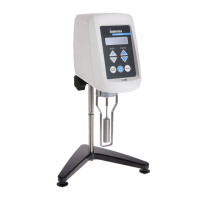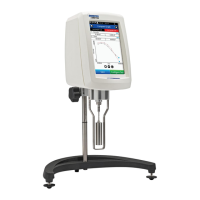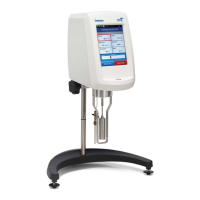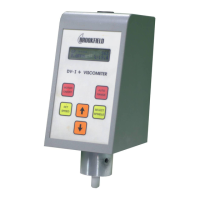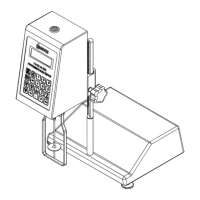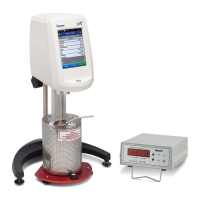Brookeld Engineering Laboratories, Inc. Page 54 Manual No. M14-023
Appendix G - e Brookeld Guardleg
e guard leg was originally designed to protect the spindle during use. e rst applications of the
Brookeld Viscometer included hand held operation while measuring uids in a 55-gallon drum. It is
clear that under those conditions the potential for damage to the spindle was great. Original construction
included a sleeve that protected the spindle from side impact. Early RV guard legs attached to the dial
housing and LV guard legs attached to the bottom of the pivot cup with a twist and lock mechanism.
e current guard leg is a band of metal in the shape of the letter U with a bracket at the top that attaches
to the pivot cup of a Brookeld Viscometer/Rheometer. Because it must attach to the pivot cup, the
guard leg cannot be used with a Cone/Plate instrument. A guard leg is supplied with all LV and RV
series instruments, but not with the HA or HB series. It’s shape (shown in Figures G-1 and G-2) is
designed to accommodate the spindles of the appropriate spindle set; therefore, the RV guard leg is
wider than the LV due to the large diameter of the RV-1 and RV-2 spindles. e RV and LV guardlegs
are not interchangeable.
e calibration of the Brookeld Viscometer/Rheometer is determined using a 600mL Low Form Grin
Beaker. e calibration of LV and RV series instruments includes the guard leg. e beaker wall (for HA/
HB instruments) or the guard leg (for LV/RV instruments) denes what is called the “outer boundary”
of the measurement. e spindle factors for the LV, RV, and HA/HB spindles were developed with the
above boundary conditions. e spindle factors are used to convert the instrument torque (expressed
as the dial reading or %Torque value) into centipoise. eoretically, if measurements are made with
dierent boundary conditions, e.g., without the guard leg or in a container other than 600 mL beaker,
then the spindle factors found on the Factor Finder cannot be used to accurately calculate an absolute
viscosity. Changing the boundary conditions does not change the viscosity of the uid, but it does
change how the instrument torque is converted to centipoise. Without changing the spindle factor to
suit the new boundary conditions, the calculation from instrument torque to viscosity will be incorrect.
Practically speaking, the guard leg has the greatest eect when used with the #1 & #2 spindles of the LV
and RV spindle sets (Note: RV/HA/HB #1 spindle is not included in standard spindle set). Any other
LV (#3 & #4) or RV (#3 - #7) spindle can be used in a 600mL beaker with or without the guard leg to
produce correct results. e HA and HB series Viscometers/Rheometers are not supplied with guard
legs in order to reduce the potential problems when measuring high viscosity materials. HA/HB spindles
#3 through #7 are identical to those spindle numbers in the RV spindle set. e HA/HB #1 & #2 have
slightly dierent dimensions than the corresponding RV spindles. is dimensional dierence allows
the factors between the RV and HA/HB #1 & #2 spindles to follow the same ratios as the instrument
torque even though the boundary conditions are dierent.
e recommended procedures of using a 600mL beaker and the guard leg are dicult for some customers
to follow. e guard leg is one more item to clean. In some applications, the 500mL of test uid required
to immerse the spindles in a 600mL beaker is not available. In practice, a smaller vessel may be used
and the guard leg is removed. e Brookeld Viscometer/Rheometer will produce an accurate and
repeatable torque reading under any measurement circumstance. However, the conversion of this
torque reading to centipoise will only be correct if the factor used was developed for those specic
conditions. Brookeld has outlined a method for recalibrating a Brookeld Viscometer/Rheometer
to any measurement circumstance in More Solutions to Sticky Problems. It is important to note that
for many viscometer users the true viscosity is not as important as a repeatable day to day value. is
repeatable value can be obtained without any special eort for any measurement circumstance. But, it
should be known that this type of torque reading will not convert into a correct centipoise value when
using a Brookeld factor if the boundary conditions are not those specied by Brookeld.

